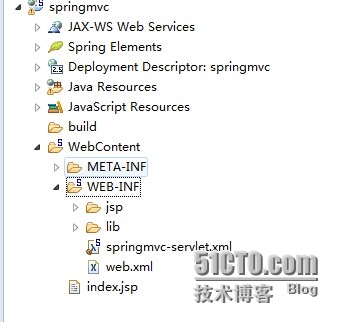springmvc+hibernate的一个简单实例
刚刚进到新的公司,看到项目都是用webservice+springmvc的形式,之前一直用的是Struts的。觉得有必要看下且记录下来。因为之前有记录过注解注入方式,但这么久没有接触了,忘记了。还好自己有记录在博客里面。
环境:spring4.0.4.RELEASE,hibernate4.3.10Final,包都是在官网上面下载。
eclipse+mysql做的springmvc+hibernate,采用的都是注解的形式。
看下工程的目录


OK,先说下步骤。
eclipse先建立一个web工程,如果你用的是web3.0的话就要创建一下web.xml(默认是不创建的)
首先看下web.xml
<?xml version="1.0" encoding="UTF-8"?> <web-app version="2.5" xmlns="http://java.sun.com/xml/ns/javaee" xmlns:xsi="http://www.w3.org/2001/XMLSchema-instance" xsi:schemaLocation="http://java.sun.com/xml/ns/javaee http://java.sun.com/xml/ns/javaee/web-app_2_5.xsd"> <display-name>springmvc</display-name> <context-param> <param-name>contextConfigLocation</param-name> <param-value>classpath:spring-beans.xml</param-value> </context-param> <listener> <listener-class>org.springframework.web.context.ContextLoaderListener</listener-class> </listener> <!-- 防止乱码 --> <filter> <filter-name>encodingFilter</filter-name> <filter-class> org.springframework.web.filter.CharacterEncodingFilter </filter-class> <init-param> <param-name>encoding</param-name> <param-value>UTF-8</param-value> </init-param> </filter> <!-- 如果不添加就会在hibernate4整合报错 --> <filter> <filter-name>OpenSessionInViewFilter</filter-name> <filter-class> org.springframework.orm.hibernate4.support.OpenSessionInViewFilter </filter-class> <init-param> <param-name>sessionFactoryBeanName</param-name> <param-value>sessionFactory</param-value> </init-param> </filter> <filter-mapping> <filter-name>OpenSessionInViewFilter</filter-name> <url-pattern>*.do</url-pattern> </filter-mapping> <!-- springmvc-dispatcherServlet--> <servlet> <servlet-name>springmvc</servlet-name> <servlet-class>org.springframework.web.servlet.DispatcherServlet</servlet-class> <load-on-startup>1</load-on-startup> </servlet> <servlet-mapping> <servlet-name>springmvc</servlet-name> <url-pattern>*.do</url-pattern> </servlet-mapping> <welcome-file-list> <welcome-file>index.html</welcome-file> <welcome-file>index.htm</welcome-file> <welcome-file>index.jsp</welcome-file> <welcome-file>default.html</welcome-file> <welcome-file>default.htm</welcome-file> <welcome-file>default.jsp</welcome-file> </welcome-file-list> </web-app>
springmvc这个servlet的名字是和WEB-INF下面的配置文件有关联的,命名方式是[servletname]-servlet.xml,我现在这里的是springmvc。
在WEB-INF下面建立一个springmvc-servlet.xml内容如下:
<?xml version="1.0" encoding="UTF-8"?> <beans xmlns="http://www.springframework.org/schema/beans" xmlns:xsi="http://www.w3.org/2001/XMLSchema-instance" xmlns:p="http://www.springframework.org/schema/p" xmlns:context="http://www.springframework.org/schema/context" xmlns:mvc="http://www.springframework.org/schema/mvc" xsi:schemaLocation=" http://www.springframework.org/schema/beans http://www.springframework.org/schema/beans/spring-beans-4.0.xsd http://www.springframework.org/schema/context http://www.springframework.org/schema/context/spring-context-4.0.xsd http://www.springframework.org/schema/mvc http://www.springframework.org/schema/mvc/spring-mvc-4.0.xsd"> <!-- 注解驱动 --> <mvc:annotation-driven /> <!-- 扫描器 --> <context:component-scan base-package="com" /> <!-- 视图解析器 --> <bean class="org.springframework.web.servlet.view.InternalResourceViewResolver"> <property name="prefix" value="/WEB-INF/jsp/" /> <property name="suffix" value=".jsp"/> </bean> </beans>
视图解析器分前缀后缀,然后和你的controller返回的字符串合成一个页面的路径。(都是可修改路径)
放在WEB-INF下面只是为了安全起见。
基本上springmvc需要配置就配好了。
下面看下controller的代码:
/**
*
* @author Daven.Tsang
*
*/
@Controller
public class HelloController {
@Resource(name="userService")
private UserService userService;
/**
*
* @param name
* @param model
* @return
*/
@RequestMapping(value = "/hello.do")
public String sayHello(Model model) {
String sql="from User";
List<User> users = userService.findAll(sql);
model.addAttribute("users",users);
return "hello";
}
}
userService是在业务注入过来的。我现在的代码是分三层,dao,service,controller(相当以前的action)也可以说是view。只是用控制器来控制视图。
返回值hello是刚刚上面所说,和前缀+hello+后缀一起定义一个页面的路径。
看下index.jsp和hello.jsp
index.jsp如下:
<form action="hello.do" method="post">
name:<input type="text" name="user_name" id="user_name"/>
<br>
password:<input type="password" name="user_pwd" id="user_pwd"/>
<input type="submit" value="submit"/>
</form>
如果你的user类有这些属性的话,就直接在controller可以拿到参数。(自动封装)
hello.jsp
<c:forEach items="${users}" var="s">
${s.user_name}
</c:forEach>
具体下载项目下来看吧。
基本上这样一个项目就搭好了。
下载地址是http://down.51cto.com/data/2075935,里面包含jar,直接导入eclipse就能用。要1颗下载豆噢,哈哈~!